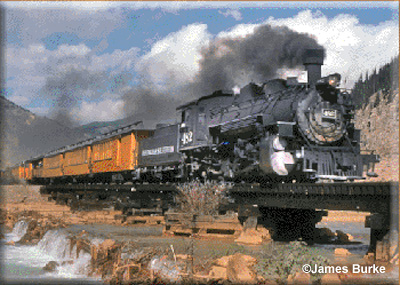March 25, 2018
Durango to Silverton


[Silverton Magazine 2010 | By Beverly Rich, San Juan County Historical Society]
All content © San Juan Publishing Group, Inc, All rights reserved.

THE SAN JUAN MOUNTAINS were home to the Utes when gold was discovered in the early 1860s. Captain Charles Baker led a party into the broad, flat valley where Silverton now sits and discovered traces of gold. Although the Civil War took center stage during the period of 1860 to 1865, it was only a matter of time before the San Juans were crawling with prospectors. Negotiations with the Utes took several years, and in 1874 the San Juans were opened up to settlement. General William Jackson Palmer had arrived in Colorado with a vision of a north-south railroad from Mexico to connect with the transcontinental railroad already in the works. The Denver and Rio Grande Railroad was incorporated and quickly built lines south to Pueblo and Alamosa, Colo. News of great gold strikes in the San Juans drove Palmer to build a railroad to Silverton, the queen city of the San Juans.
Silverton was incorporated in 1874, and soon other towns like Lake City, Eureka, and Ouray were settled, as well as camps like Animas Forks. The main route into Silverton was a “wagon road” over Stoney Pass from Salida. To say that it was passable by wagon was stretching the truth—many times wagons had to be moved with block and tackle cinched to trees. Getting the ore out of the mountains and supplies into the mining camps was expensive and difficult. On July 27, 1881, the D&RG arrived in what is now Durango. Two miles north up the valley was Animas City, a modest settlement of around 300. The city fathers were ecstatic—surely Animas City was destined for greatness. But the D&RG wanted concessions that the leaders of Animas City were not willing to give, so the railroad laid out the new city of Durango and started construction up the canyon to Silverton. Today old timers still call the north part of Durango “Animas City.”
With the arrival of the Denver & Rio Grande Railroad to Silverton in 1882, ore was easily exported, and supplies were easier to get. Silverton was the center of commerce for the region—you could buy anything from a top hat and cigar to dynamite and blasting wire. Soon other entrepreneurs followed—men like Otto Mears, the “Pathfinder of the San Juans” who built railroads further into the mountains to make it easier to get their riches out. Durango became a smelter town—rich ores mined and milled at mines like the Sunnyside, the Old Hundred and the Silver Lake were now shipped south to be smelted. Agricultural towns like Bayfield and Mancos grew up around Durango to serve as suppliers to the rough and tumble mining towns to the north
In the years since, several of the boom and bust cycles typical of the mining industry happened, making fortunes and then sending them plummeting. The boom cycles saw an influx of people from every ethnic group on earth, and the bust cycles saw towns turn into ghostly reminders of themselves. Today Silverton is the only town left in San Juan County, with a population of 500, supported by tourists who ride the rails to see the magnificent scenery and experience the incredible history of the area.
Photographs
Silverton Train approaching Silverton. ©James Burke for San Juan Publishing
The Silverton Magazine was published by San Juan Publishing from 2000-2010. All content is copyright, in perpetuity, San Juan Publishing, Group, Inc. All rights reserved. For reprint permission, contact the publisher.
